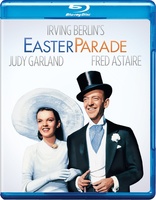Easter Parade Blu-ray Movie
HomeEaster Parade Blu-ray Movie 
Warner Bros. | 1948 | 103 min | Not rated | Feb 19, 2013Movie rating
7.3 | / 10 |
Blu-ray rating
| Users | 4.0 | |
| Reviewer | 3.5 | |
| Overall | 3.6 |
Overview
Easter Parade (1948)
Don Hewes and Nadine Hale are a dancing team, but she decides to start a career on her own. So he takes the next dancer he meets.
Starring: Judy Garland, Fred Astaire, Peter Lawford, Ann Miller, Jules MunshinDirector: Charles Walters (I)
| Romance | Uncertain |
| Musical | Uncertain |
Specifications
Video
Video codec: MPEG-4 AVC
Video resolution: 1080p
Aspect ratio: 1.37:1
Original aspect ratio: 1.37:1
Audio
English: DTS-HD Master Audio Mono (48kHz, 24-bit)
Spanish: Dolby Digital Mono
Spanish: Dolby Digital Mono (Spain)
German: Dolby Digital Mono
Portuguese: Dolby Digital Mono
Subtitles
English SDH, French, German SDH, Portuguese, Spanish
Discs
50GB Blu-ray Disc
Single disc (1 BD)
Playback
Region A, B (C untested)
Review
Rating summary
| Movie | 4.0 | |
| Video | 4.0 | |
| Audio | 3.0 | |
| Extras | 2.5 | |
| Overall | 3.5 |
Easter Parade Blu-ray Movie Review
With SOME of the Frills Upon It
Reviewed by Michael Reuben February 19, 2013Easter Parade is the kind of big, scented bouquet of a musical for which MGM was renowned in the golden age of the studio system. It famously represents the only screen pairing of two huge stars, Judy Garland and Fred Astaire, but that literally happened by accident. Gene Kelly was supposed to play the male lead but broke his ankle shortly before filming began. At Kelly's suggestion, Astaire came out of retirement to step into his dancing shoes. Kelly's was not the only injury that affected casting. Cyd Charisse was set to co-star as the dancer Nadine, but was sidelined with torn ligaments in the knee. The role went to newcomer Ann Miller, who herself was suffering from a major back injury (a product of spousal abuse) and performed the role in a brace. The film launched her career. Garland's husband, Vincente Minnelli, was originally attached to direct, but Garland was advised (some say by her shrink) not to work with her husband again. The task fell to Charles Walters, who had only recently made the transition from choreographer to feature director, but his experience proved ideal for a film about dancers and their tribulations, both romantic and professional. (Walters would go on to great success with films such as High Society and The Unsinkable Molly Brown.) Long before Broadway invented the term "jukebox musical" for shows like Jersey Boys, Hollywood was already creating them. The script for Easter Parade was written to accommodate an existing catalog of songs by Irving Berlin, arguably the era's most popular songwriter. Berlin agreed to write several new songs, and the film was marketed, then as now, as "Irving Berlin's Easter Parade". The title song had already been used in the 1942 film Holiday Inn starring Astaire and Bing Crosby, and its popularity guaranteed name recognition.
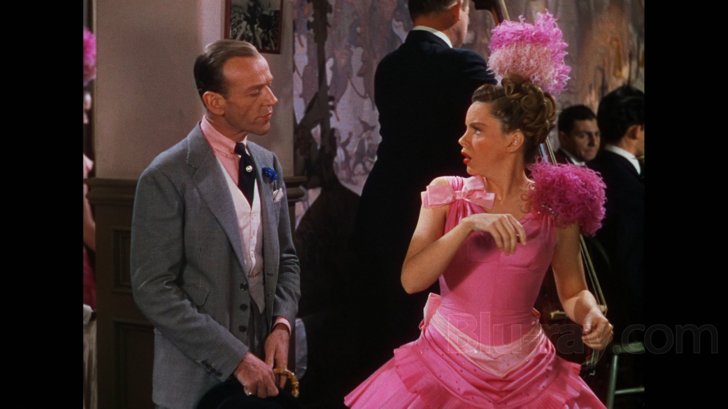
The year is 1912, and it's the heyday of vaudeville. One of the most successful acts on the circuit is the dancing team of Don Hewes (Astaire) and Nadine Hale (Miller), who are also a couple. But Nadine splits up the act and the relationship when she announces, to Don's amazement, that she's been offered a job as a solo act. Nadine also seems to have developed an interest in Don's best friend, Johnny Harrow III (Peter Lawford), a charming but perpetually uncommitted playboy. Hurt and angry, Don sits drinking at a bar that night, telling Johnny that he made Nadine what she is, and he can replace her with anyone he chooses. To prove his point, he pulls a chorus girl off the saloon's tiny stage and tells her to report for rehearsal the next morning. Her name is Hannah Brown (Garland), and when she realizes that she's been offered a job by the famous Don Hewes, she hands in her notice and obediently reports as ordered, where a hungover Don is wondering what he's gotten himself into. The relationship between Don and Hannah develops through song and dance, as they create an act together, which, after a few mishaps, is enough of a hit to get them an offer from Mr. Ziegfeld, the greatest vaudeville impressario of his day. But success comes at the cost of putting the newly minted duo into direct competition with Nadine, which also forces Don to sort out his true feelings. While Don is doing so, Johnny re-enters the picture, with his roving eye having now lit on Hannah. (Johnny, it seems, selects the objects of his romantic interest by following his best friend around.) The story reaches its inevitable conclusion at the Easter Parade on Fifth Avenue with a then-state-of-the-art effects shot achieved on the MGM backlot, set against the strains of Garland's Hannah singing Berlin's signature tune. It's a bookend to the marvelous opening, in which Astaire's Don dances down Fifth Avenue buying various gifts in anticipation of Easter, including a stuffed bunny in a store that resembles the old F.A.O. Schwarz in a dance routine with drums to a song called, appropriately enough, "Drum Song". The film's single most famous number is "A Couple of Swells", performed by Garland and Astaire dressed as tramps, but numerous other sequences stand out. The so-called "vaudeville montage" showing Don's and Hannah's progress is a showcase of Berlin standards, including "I Love a Piano" and "Snookie Ookums", while "I Want to Go Back to Michigan", which Hannah sings just after Don has offered her a job, is a showcase for Garland. "It Only Happens When I Dance with You" is the film's love song; it is performed first by Don and Nadine, then reprised by Hannah, and again by Nadine when she tries to get Don back. And finally, the massive production number, "The Girl on the Magazine Cover", provides a taste of vaudeville at its most glamorous—and shows us why Nadine went out on her own. A non-musical highlight of the film is a restaurant presided over by a headwaiter named François (Jules Munshin), where various groupings of the principal characters keep gathering, but no one ever seems to complete their order. François' reactions to these personal and professional tiffs, as well as his elaborate demonstration of how to make a salad, rank near the top of the comic delights of Easter Parade.
Easter Parade Blu-ray Movie, Video Quality 
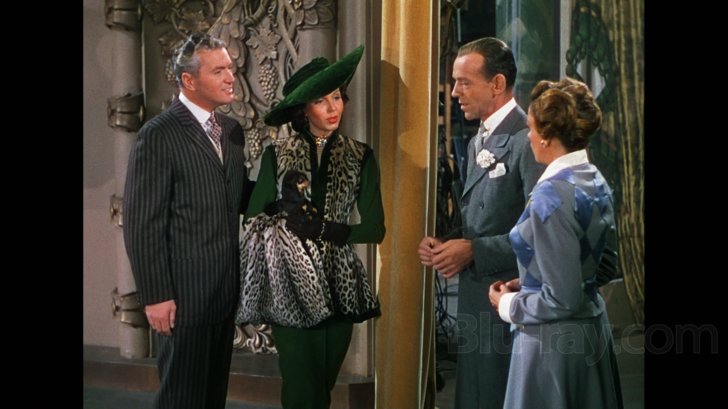
If memory serves (and I encourage any reader with definitive information to assist me here), Warner created the DVD of Easter Parade using the same proprietary process for restoring three-strip Technicolor that was applied to Singin' in the Rain, The Adventures of Robin Hood and Meet Me in St. Louis. The results were well- received in 2005, but I do not know whether a new scan was performed for this 1080p, AVC-encoded Blu-ray, nor do I have the DVD for comparison. What I can report is that the Blu-ray has excellent blacks, vivid, richly saturated colors, a very good level of fine detail and a natural-looking grain pattern that appears undisturbed by digital tampering. To the extent there is anything negative to report, it is the slight and very subtle color shifts that will be familiar to any viewer of Technicolor restorations from this era, where the entire palette vacillates back and forth. The effect is most readily observable in backgrounds or large expanses of a single light color. It's not a major issue in Easter Parade, and many viewers may never notice it, but it caught my attention enough to warrant mention. Other than this reminder that even the best restoration can't solve everything, no artifacts were in evidence.
Easter Parade Blu-ray Movie, Audio Quality 

The film's original mono soundtrack is presented as DTS-HD MA 1.0, and it gets the job done reasonably well most of the time. The singing voices of Garland, Astaire and Miller come through unscathed, and the limitations of Lawford's voice are well camouflaged. The only voice that tests the limits of the 1948 source is that of Richard Beavers, who performs "The Girl on the Magazine Covers" and whose higher and more powerful notes strain the dynamic range of the contemporary recording technology. The orchestral backing obviously can't supply the lush presence that one would expect from a current recording, but given the source it does remarkably well. When the songs are by Irving Berlin, you don't need the orchestra to sweep you away.
Easter Parade Blu-ray Movie, Special Features and Extras 
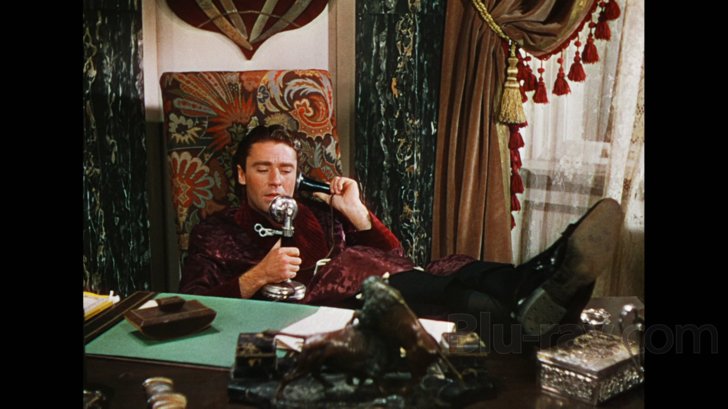
The extras have been ported over from the two-disc special edition DVD released by Warner in 2005, but not all of the DVD extras have been retained. The DVD set included a Judy Garland trailer gallery, while the Blu-ray has only a single trailer for Easter Parade. The second DVD in the set was primarily taken up with a two-hour American Masters documentary entitled Judy Garland: By Myself. This item is listed on the Blu-ray jacket, but it doesn't appear on the disc.
- Commentary with Ava Astaire McKenzie and John Fricke: McKenzie is Astaire's daughter, and Fricke is Garland's biographer. Their commentary is an amiable chat between people with a wealth of information about Easter Parade, informed by an obvious affection for the film and everyone involved in it. Mrs. McKenzie's personal memories of her father and his ongoing friendships with Garland and Berlin are especially entertaining.
- Easter Parade: On the Avenue (480i; 1.33:1; 34:25): This informative 2005 documentary on the making of the film includes interviews with McKenzie and Fricke (both of whom cover some of the same ground as in the commentary but also cover other aspects of Astaire's and Gardland's careers), as well as with screenwriter Sidney Sheldon and Ann Miller. The collection of archival photographs and newsreel footage is impressive.
- "Mr. Monotony" Outtake (480i; 1.33:1; 3:09): This musical number was cut from the film. A shortened version first appeared in the MGM documentary, That's Entertainment! III (1994).
- "Mr. Monotony" Dailies (480i; 1.33:1; 18:11): Multiple takes of the various shots from the cut number.
- Radio Promo (audio only; 4:24): Not just an announcement, but a complete interview with Astaire, in which he discusses such subjects as his return from retirement for Easter Parade, his love of dancing and his lengthy rehearsal period for each film.
- 3/11/1951 Screen Guild Theater Broadcast (audio only; 54:00): Garland and Astaire reunited for this one-hour radio version of Easter Parade, of which the chief attraction was their rendition of the Irving Berlin songs. Lawford also appears.
- Theatrical Trailer (480i; 1.33:1; 1:59): I'm not sure everyone would agree today that Easter Parade is Garland's "greatest musical", but it's certainly memorable.
Easter Parade Blu-ray Movie, Overall Score and Recommendation 
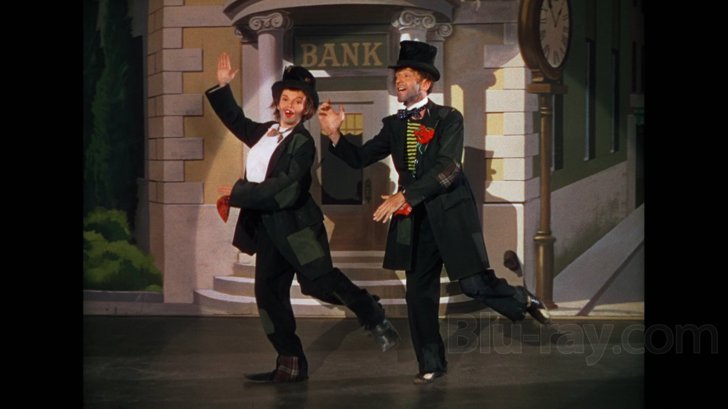
By leaving a major extra off the Blu-ray, Warner hasn't made things easy for prospective purchasers. Lovers of classic film tend to be big fans of documentaries like the omitted Judy Garland: By Myself, and a first-time purchaser might reasonably decide to accept the trade-off of DVD's lower resolution in exchange for a substantially more extensive collection of historical materials. Those who already own the two-disc special edition DVD might reasonably ask whether the Blu-ray's image offers sufficient improvement to justify the upgrade. (The sound, though lossless, is limited by the quality of the source.) What Warner should have done was to include the second disc from the DVD set as a bonus disc with the Blu-ray, although I suspect that would have entailed additional licensing fees the studio did not wish to incur. The bottom line is that the best possible edition of Easter Parade requires the purchase of both formats. I am not making a recommendation, just presenting the options. If you love the film, you'll know what to choose. (Update: Purchasers of this disc have reported on the Blu-ray.com forum that contacting Warner customer service through this link has resulted in their being sent the second disc of the DVD set, which contains the missing documentary.)
Similar titles
Similar titles you might also like

Meet Me in St. Louis
1944

Hello, Dolly!
Fox Studio Classics
1969

The Band Wagon
1953

An American in Paris
1951

Victor/Victoria
1982

On the Town
1949

Stormy Weather
Limited Edition to 3000 - SOLD OUT
1943

Xanadu 4K
1980

Summer Stock
Warner Archive Collection
1950

The Last Five Years
2014

Cover Girl
Limited Edition to 3000 - SOLD OUT
1944

It Started with Eve
1941

Hello, Frisco, Hello
Limited Edition
1943

South Pacific
50th Anniversary Edition
1958

Music in My Heart
1940

Oklahoma! - Platinum Edition
1955

Guys and Dolls
Warner Archive Collection
1955

Good News
Warner Archive Collection
1947

Singin' in the Rain 4K
70th Anniversary Edition
1952

Brigadoon
1954
